Ref : https://bahairecollections.com
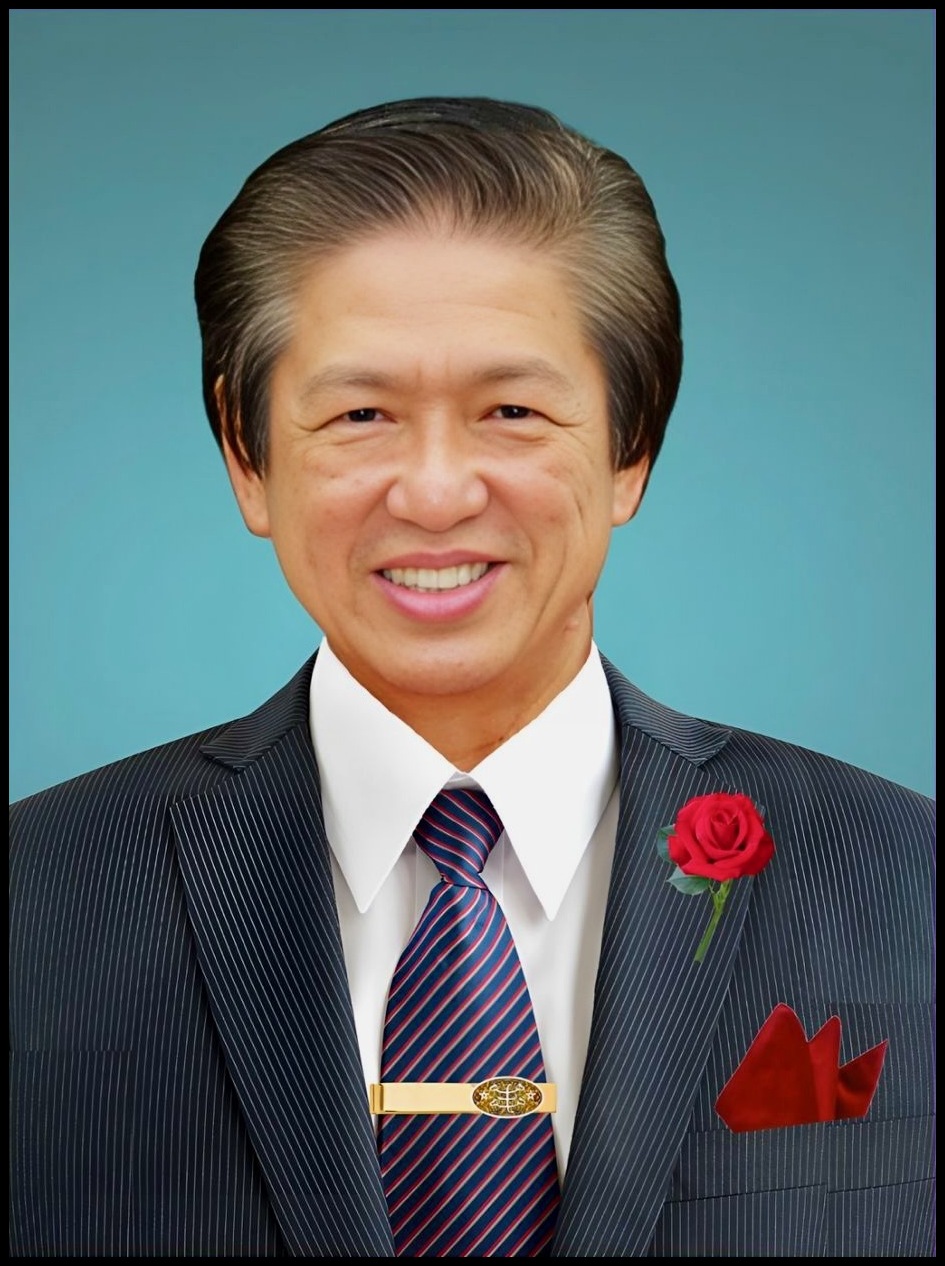
19 November 1943 to 18 July 2024
Boo Haw was a dedicated field worker from the very beginning, known for his goal-oriented approach and unwavering focus on achieving the objectives set by the national institution and the Kedah State Teaching Committee. The Bahá’ís of Alor Star would drive down to the estates around Central Kedah State to visit and deepen the believers. Among those who undertook this task were Chinese speaking believers such as Chong Boo Haw, along with Yin Hong Shuen, Teh Teik Cheow, Tan Boon Tin, Teh Teik Hoe, Phung Woon Khing, Peter Chew Huat Chin and Mei Siew Hong. These Bahá’ís, without the knowledge of the Tamil language created an impact among the rubber plantation settlement (estate) workers who were pleasantly surprised to see Chinese visitors.
They would drive down to Sungei Petani and take along the local Bahá’í s of Sungei Petani to do estate teaching in various parts of Kedah. Boo Haw was one of those who went for estate teaching. Apart from teaching trips to the estates he also attended Bahá’í weddings. Kulim town was a difficult place in the early 1970s, and Boo Haw joined other believers of Alor Star, Glugor and Georgetown in Penang in visiting the community for consolidation. In 1972 the Kulim believers were able to rent their own Bahá’í centre.
In 1972 he was appointed into the Area Teaching Committee of Kedah, and he had to undertake several teaching trips in this state to win the goals of the National Spiritual Assembly assigned to this region. Boo Haw was always goal oriented in his teaching efforts.
He organised personal teaching trips to difficult areas such as Kelantan state, paying for all expenses. In one trip to Kelantan by two carload of believers, Boo Haw had with him all the Bahá’í contacts in the state of Kelantan and met almost all of them. When meeting them he presented them with Bahá’í gifts such as prayer books and other Bahá’í books. He did not spare the Aboriginal (Asli) villages as well.
He carried some Bahá’í pamphlets with him started conversation with fellow passengers and when opportunity presented itself he would present the Faith. Whenever someone arose to teach the Faith, Boo Haw was very supportive and provided every possible assistance. At times when he could not undertake teaching trips, he would subsidize them. In 2019 Dr. Firaydun Mithaq passed through Alor Star on his way to Padang Lembu Estate where he wanted to teach the Cause. Since he planned to stay for about four months, he asked Boo Haw to assist him in renting a car. But Boo Haw gave his own car with which Firaydun was able to drive around and teach the Cause and deepen the believers in Padang Lembu Estate. During these four months Firaydun alternated between his home in Chiang Mai and Padang Lembu Estate.
TEACHING TRIPS ABROAD
The Bahá’ís of Alor Star continued to maintain intimate connection with South Thailand even in the 1980s and beyond. The National Spiritual Assembly of Thailand and Malaysia worked out a joint program to assist in the development of the Faith in South Thailand. The official South Thailand Border Teaching Committee was formed in 1967, an idea emanating from the brilliant mind of Hand of the Cause of God Dr. Muhájir. This committee took different names over the years. In the 1980 it came to be called the Border Teaching Committee, supported by the Regional Teaching Committee of South Thailand and several assemblies in West Malaysia. Chong Boo Haw, Teh Teik Hoe and M. S. Maniam of Alor Star, Wong Boon Tok of Kangar, Chew Beng Cheong of Penang and Vijayan Joseph of Butterworth were on this Committee. Chong Boo Haw himself was Chairman while Vijayan Joseph was Secretary of this committee for several years. They met once in a month at the residence of Victor Greenspoon in Hat Yai to plan out their activities. Members of the committee were assigned different places in South Thailand. Chong Boo Haw was assigned Pattalung and Yasathon, while Teh Teik Hoe was assigned Phuket. Yet when these valiant soldiers went for teaching, they took along others as well. Among them were Liu Man San and Doreen, Thomas Siew, Leong Foo Cheong. Nagendran from Kuala Lumpur too joined Boo Haw from time to time in spreading the Cause in South Thailand. The non-working youth were usually broke, but the adults especially Boo Haw would take care of their expenses. Their activities included teaching in the streets and in villages, singing in the parks and beaches, making bold presentation in universities and teacher training colleges.
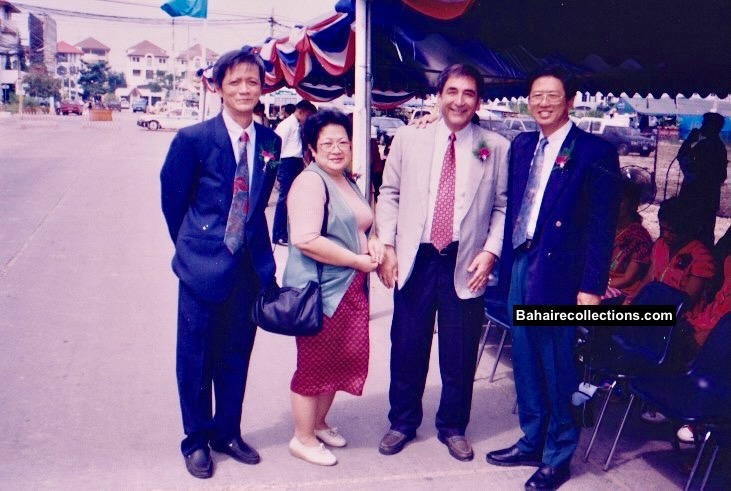
Official opening of the new Bahá’í Centre at Bangkok on 26 November 1998. L-R: Wong Boon Tok. Mrs. Chusiri, Sukhum Abhasakun Faridian and Boo Haw.
In early 1980 the Supreme Body requested the Malaysian Bahá’í community to provide assistance for the development of the Faith in Burma (Myanmar). Several individuals arose to answer the call. In the early 1980s Boo Haw booked two air tickets- one for himself and the other for his friend Leong Foo Cheong and arranged visas for both to answer the call of the Supreme Body. They both went for travel teaching in Myanmar for a week. Apart from Rangoon, the went to ‘Abdu’l-Bahá’s village in Daidanaw as well. Boo Haw told many stories to inspire the believers, and his guitar was there to boost their spirit. Boo Haw and N. S. S. Silan went to Myanmar in 2016 and joined in the youth gathering held in the Bahá’í Centre in Yangon.
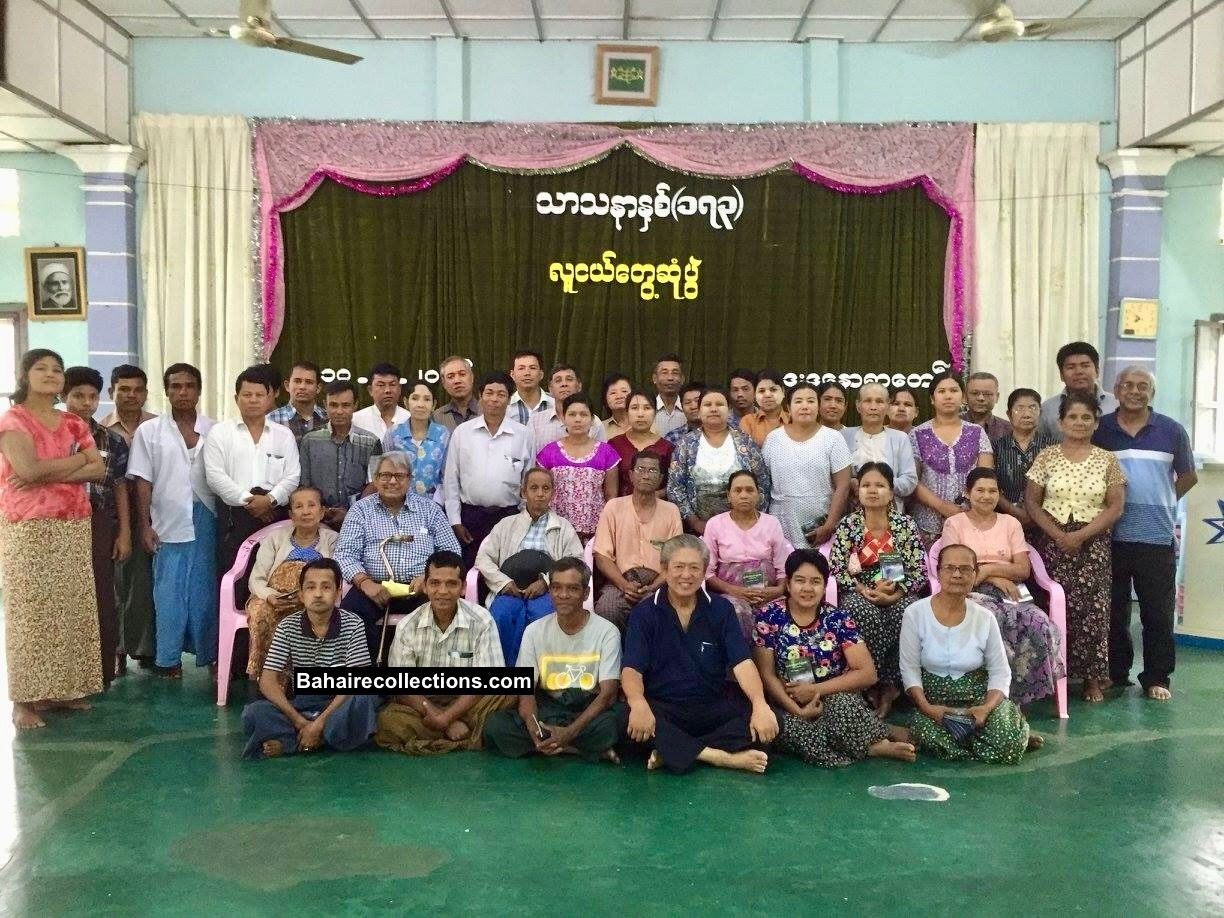
Youth gathering at Yangoon, Myanmar, 2016. Boo Haw is seated in the centre, on the floor. N. S. S. Silan stands at the extreme right.
In 1987 he went to Papua New Guinea for travel teaching and to meet up with his old friends like Leong Ho San, Tan Keat Fong and N.S.S Silan. He was taken to meet the believers in Port Moresby and some village communities. In the two weeks Boo Haw was in Papua New Guinea, he cheered the friends through strumming his guitar and telling some Bahá’í stories.
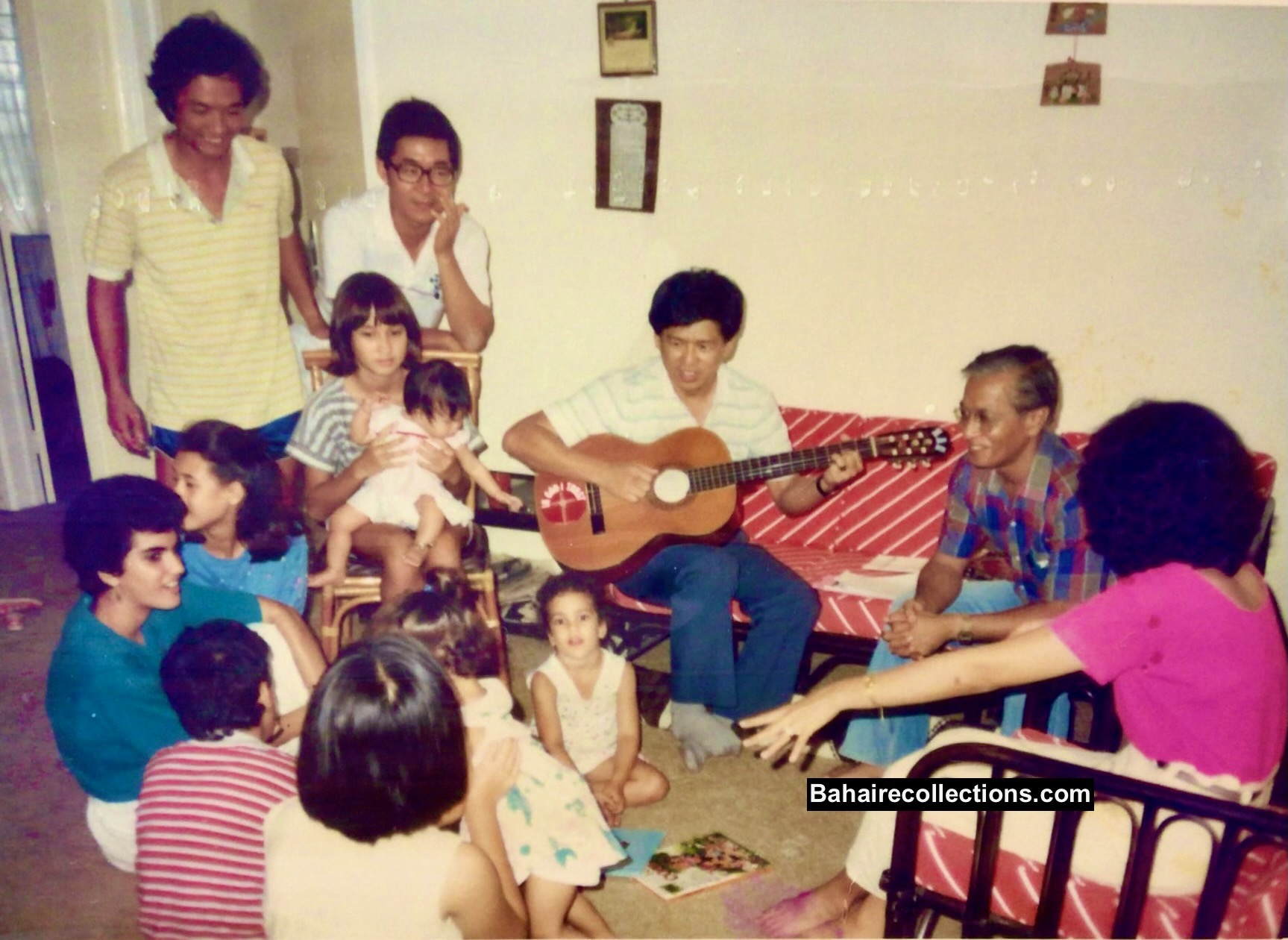
Boo Haw plays guitar during his visit to Papua New Guinea in October 1987. Leaning on a chair at his back is Tan Keat Fong.
Boo Haw was known to make sudden decisions to undertake sudden teaching trips. One of such trips was undertaken to Chiang Mai in 2021. He took his wife, and David Soo, a believer from Butterworth for a teaching and consolidation visit to Chiang Mai in Thailand where they stayed in the home of Dr. Firaydun Mithaq, a pioneer from Iran to Laos since 1982 but settled in Thailand. In this one-week trip, Firaydun took them to visit the community, meet individual believers and teaching as well. Even in his last days when his health was deteriorating, Boo Haw pulled along Leong Foo Cheong for street teaching in Hat Yai, South Thailand.
DEEPENING CLASSES
As an avid reader, Boo Haw was well conversant not only in the Bahá’í Faith, but on the subject of comparative religions as well. He became highly knowledgeable in Christian subject. Not that he wanted to master this subject, but some situation forced him to throw himself into mastering Christianity. In about 1966 Boo Haw was courting Miss Lim Swee Geok @ Lim Siew Gaik, whom he was to marry later. As she was a staunch Catholic, Boo Haw went deep into studying the Bible to convince her on the return of the Father. In the course of this effort, he mastered the Book and later conducted in-depth study classes on the subject of Christianity and the Bahá’í Faith, to the astonishment of the participants.
He was constantly in touch with the Bahá’í bookshop in Kuala Lumpur and purchased the latest on the shelf. Whenever one conversed with Boo Haw on any subject, he not only had the ability to quote the books but would give complete and convincing answers. He had great analytical mind.
His depth in the Holy Writings came to the fore at the Kedah Peak retreat held from 25 to 27 July 1971 when twenty believers were gathered. When Boo Haw spoke on the Writings the believers listened to him wrapped in full attention and delight.
MUSICAL BOO HAW
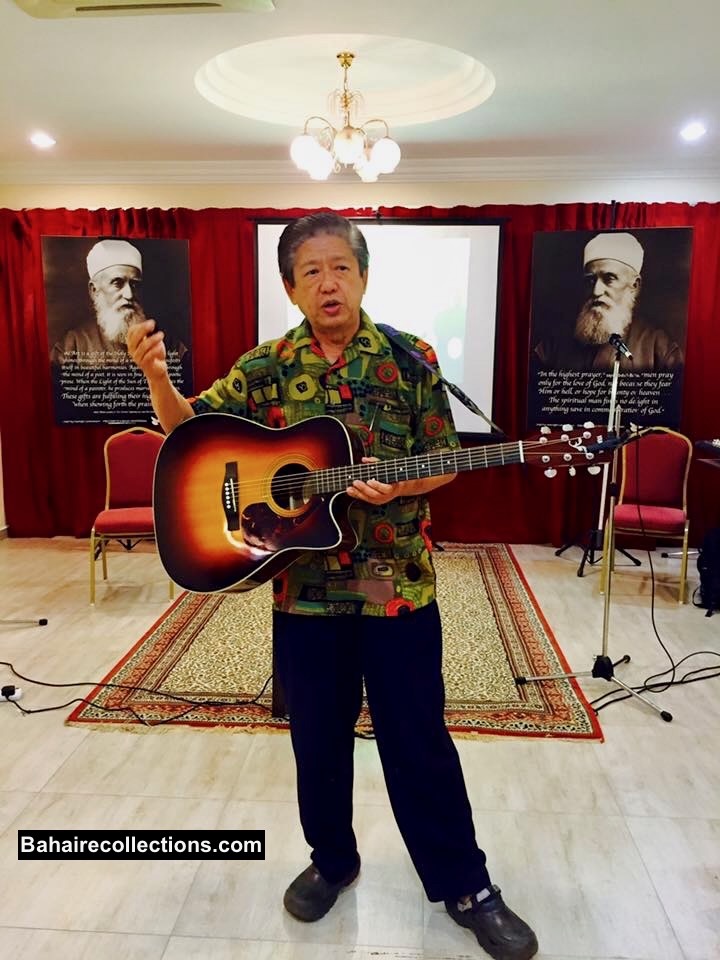
The Stellar Performer Boo Haw.
We have ample statements in the writings pertaining to music. Bahá’u’lláh says in The Kitáb-i-Aqdas, “We, verily, have made music as a ladder for your souls, a means whereby they may he lifted up unto the realm on high . . .” ‘Abdu’l-Bahá asserts that “music, sung or played, is spiritual food for soul and heart.” The Beloved Guardian has said, “It is the music which assists us to affect the human spirit; it is an important means which helps us to communicate with the soul”. Boo Haw was well endowed with music talent- one of the gifts of the Holy Spirit and has used this talent predominantly, or even fully for the Cause. His affinity for songs was rooted in his intuitive understanding of music. As years rolled by, he became an iconic figure as a roving ambassador in the promotion of the Faith through music. He became a household name in Malaysia in entertainment of gatherings through his songs and guitar. He truly established himself as the quintessential singer.
In Malaysia, the first musical fireside was organised by the Bahá’ís of Bagan Serai in the year 1966. The Bahá’ís of Bagan Serai purchased musical equipment and held a musical fireside at Sungei Gedung Estate. That was short lived. This format of teaching through music took a serious note in 1970 with the youth of Alor Star and Penang teaming up to form the Malaysian Bahá’í Musical Group.
Boo Haw was a talented musician from schooldays. Along with music his other extraordinary talents too blossomed in those tender years and showed up in greater proportions in later years. During the early 1960s Boo Haw would go to the house of the brothers Teh Teik Cheow and Teh Teik Hoe, sometime bringing his record of the Everly Brothers. He would play his record and the three would listen and sing together. Coincidentally Teik Hoe and Boo Haw would pair up as singers. In stages Boo Haw became a collector of albums such as Everly Brothers, Simon and Garfunkel and Seals and Crofts. The early 1970s was the time when a new attempt was made to convey the Bahá’í Teachings in a different format altogether- though music.
In August 1970 the famous Alor Star Youth Choir which later became The Alor Star Bahá’í Choir had its genesis at the back portion of Central Malaysia Finance office where Boo Haw worked. After office hours Boo Haw would gather a few singers to practice songs made popular by Bahá’í composers from America like the late Russ Garcia of the Bahá’í Victory Chorus fame. The members of the choir were Chong Boo Haw, Teh Teik Hoe, Remala and Nirmi Nagaratnam, Kamachee, Teh Hong Choo, Ch’ng Suan See, Tan Boon Tin, and Chandrasegaran. Boo Haw and Teh Teik Hoe were both singers and guitarists who wrote lyrics and composed music. The Alor Star youths were the first to print postcard with a photograph of a Bahá’í choir in action. Chong Boo Haw has always been called the “Elvis Presley of Malaysia” for his artistic talents in the field of singing. He could simply impersonate him to the very walk. In no time Boo Haw had taken on an iconic status in the singing circle both locally and abroad.
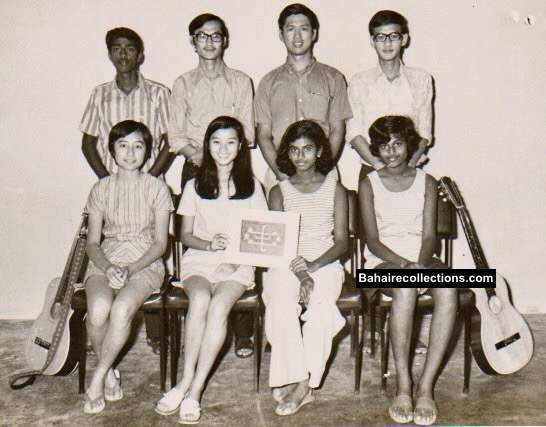
The budding Alor Star Bahá’í Choir, 1971. Seated L-R: Ch’ng Suan See, Teh Hong Choo, Remy and Nirmy. Standing L-R: Chandrasekaran, Teh Teik Hoe, Chong Boo Haw and Tan Boon Tin.
In 1971, the Alor Star Bahá’í Choir produced a songbook called “Sing Out Bahá’ís.” It cost only RM 2.00 per copy. Whoever wanted the 30 songs was requested to supply empty audiocassettes to the Alor Star Bahá’í Choir. Tan Lee Soo Hock of Penang, Chong Boo Haw and Teh Teik Hoe of Alor Star composed original songs. These songs were also recorded in cassettes and distributed. A number that was collectively composed by Chong Boo Haw and Tan Lee Soo Hock was called “Matchless Day.” The songs that Boo Haw composed himself were “Covenant”, “The Apple Falls”, and “Quest for Peace”. The “Apple Falls” is a song that talks about the proof of existence of God, which was composed with soul-touching lyrics after listening to a recorded talk by the Hand of the Cause of God Mr. Abu’l-Qásim Faizí. When David Garcia, son of Russ Garcia visited Malaysia in 1979 he assisted in creating further taste for music.
When Teh Teik Hoe and T. K. Lee were pioneering in Hong Kong, Boo Haw was a sad man. He too wanted to join them but his commitment to his father’s tasks did not permit him. Yet he looked out for some opportunities elsewhere. N.S.S. Silan of Petaling Jaya who was pioneering in Kenya, Africa invited Boo Haw to join him in Africa. Boo Haw immediately wrote a letter to Teh Teik Hoe on this matter. Part of that letter dated 20 January 1973 reads, “Silan has written two more letters. He is top form there. Full of wit too. Wish I were there with him. He says Africa needs singers and with his singing (you know his singing!) he is in top demand! How about you and me going there? I am desirous. Think about it. Meditate on it and then tell me.”
The real turning point of the Alor Star Bahá’í Choir was in 1973. In December 1972 Boo Haw was singing at the Winter School in Johor Bahru to standing ovation. His hit song was “Go Ye Forth” a song that was originally composed by Teik Hoe. Inspired by this Winter School, Boo Haw started writing more songs upon returning to his hometown Alor Star. He was cyclostyling a new song book and planning to come out with a new song book. He was planning to buy a new guitar and cutting a new album as soon as Teik Hoe returned from Hong Kong. While Boo Haw was composing some songs on his own in Alor Star, Teik Hoe too was doing the same while in Hong Kong. When Teik Hoe returned from Hong Kong in 1973, these two teamed up to strengthen the Alor Star Bahá’í Choir. They joined hands and composed more songs in Alor Star. Over weekends they would visit the Penang Bahá’í Choir to give a helping hand and exchange notes. It was in 1973 that the Alor Star Bahá’í Choir led by Boo Haw and Teik Hoe teamed up with the Penang Bahá’í Choir and became known as the Malaysian Bahá’í Musical Group. All along they were having localised musical events.
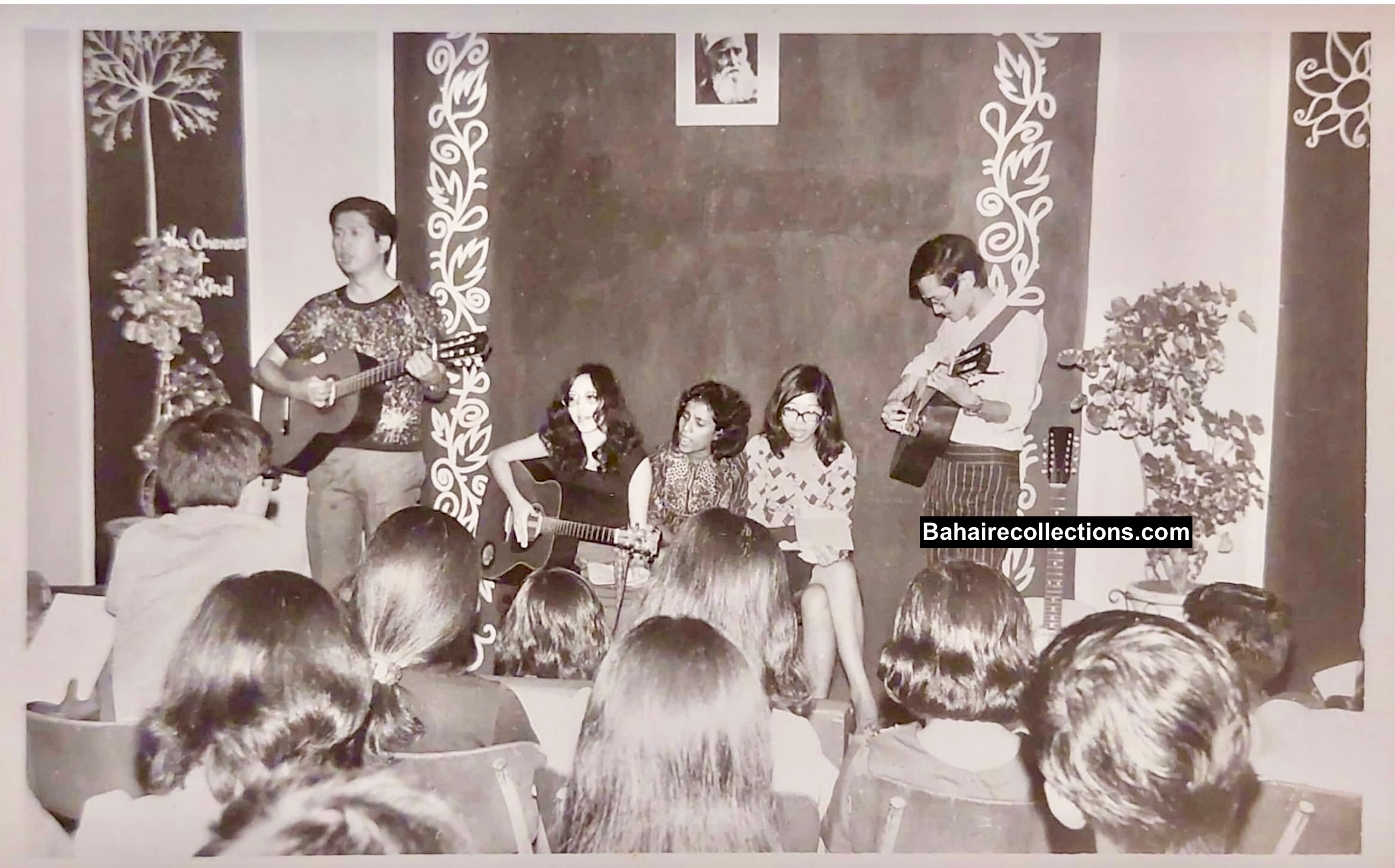 Musical fireside in Alor Star Bahá’í Centre, 1973. The performers L-R: Boo Haw, Tan Gaik Bee, Susheel Sundram, Christine Soon and Teh Teik Hoe (Photo Courtesy: Teh Teik Hoe)
Musical fireside in Alor Star Bahá’í Centre, 1973. The performers L-R: Boo Haw, Tan Gaik Bee, Susheel Sundram, Christine Soon and Teh Teik Hoe (Photo Courtesy: Teh Teik Hoe)
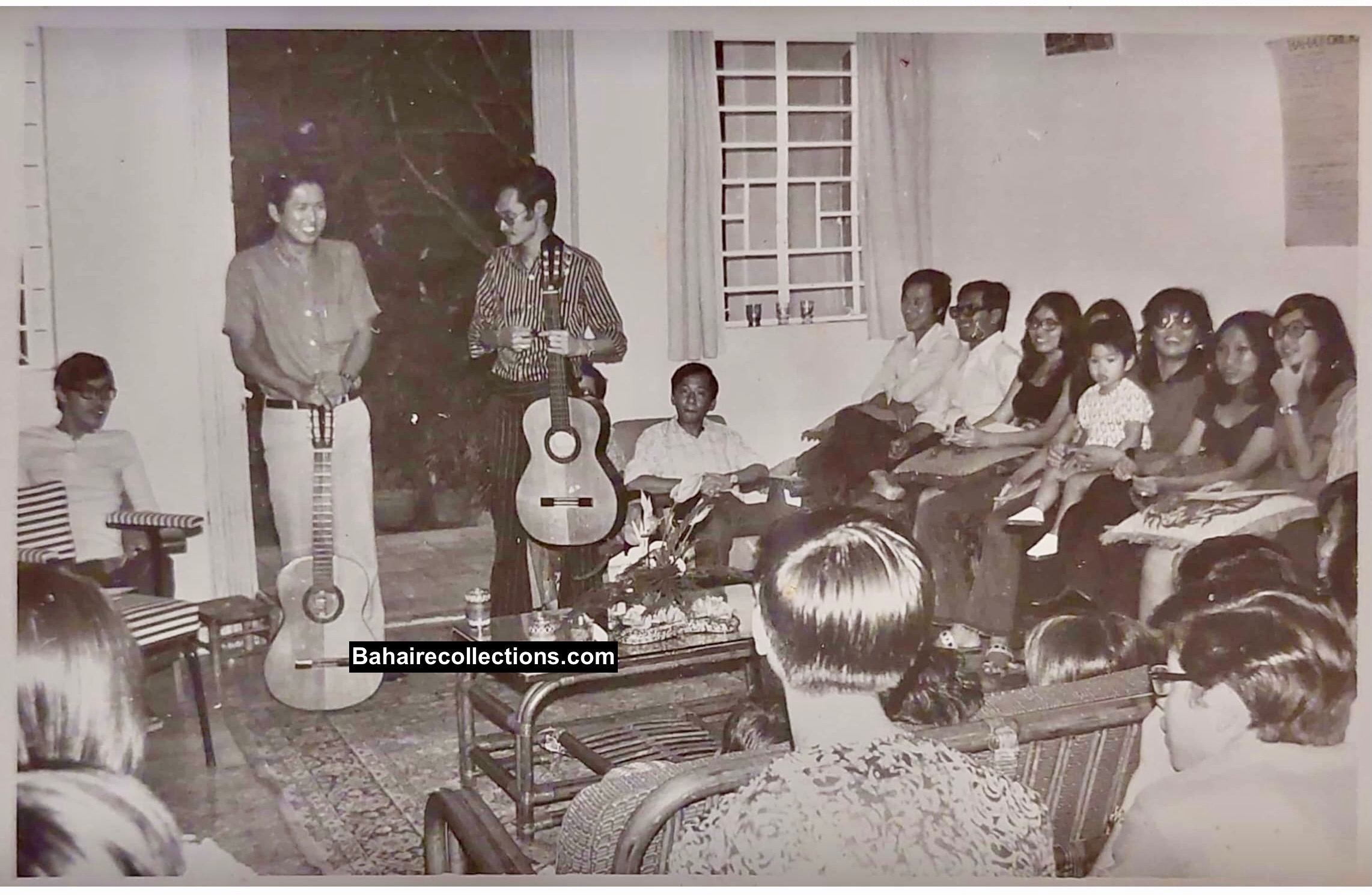 Musical Fireside held at the residence of Lily Jansz in Penang, 1973. The two Alor Star believers with guitar are Boo Haw at left and Teik Hoe at right. (Photo Courtesy: Teh Teik Hoe)
Musical Fireside held at the residence of Lily Jansz in Penang, 1973. The two Alor Star believers with guitar are Boo Haw at left and Teik Hoe at right. (Photo Courtesy: Teh Teik Hoe)
Then came the next leap. This group performed on a larger scale for a larger audience at the St. John’s Ambulance Hall in Ipoh town during the Summer School in July 1973. The musical fireside was repeated at the National Bahá’í Youth Conference at Port Dickson in December 1973. Close to fifty from the audience accepted the Faith at the performance in Port Dickson, and manpower was immediately needed for consolidation. The author volunteered to consolidate them. There were several performances in Seremban, Singapore (in conjunction with the Winter School held at the Tanah Merah Holiday Camp from 26 to 29 December 1974, and another public performance also held at the Mac Ritchie Park after the Winter School, Petaling Jaya, Genting Highlands and Setapak in later years. In 1975 the team also went to perform in Hong Kong and Thailand, with the Thai television providing good coverage.
 The first large scale musical fireside at the St. John’s Ambulance Hall in Ipoh town, July 1973. L-R: Boo Haw, Tan Lee Soo Hock, Shirley Kwan, Teh Teik Hoe, Lim Li Swan, Tan Gaik Bee, Malini Sundram, Susheel Sundram, Padma Sundram, Choy Voon Keng, Christina Soon and Steven.
The first large scale musical fireside at the St. John’s Ambulance Hall in Ipoh town, July 1973. L-R: Boo Haw, Tan Lee Soo Hock, Shirley Kwan, Teh Teik Hoe, Lim Li Swan, Tan Gaik Bee, Malini Sundram, Susheel Sundram, Padma Sundram, Choy Voon Keng, Christina Soon and Steven.
As the audience were the enquirers, musical firesides required a lot of practice, and they had to be professional. However, as the members of the Bahá’í Choir dispersed, there were none left to continue this form of fireside. Owing to the sensation the musical firesides had created in Malaysia and abroad many local communities started organising the same, but not striking the score of the Malaysian Bahá’í Choir Group.
At the International Teaching Conference held in Hong Kong in November 1976, different countries staged singing sessions during the evenings. The Malaysian participants already consisted of ready-made singers who were trained in the Musical Firesides. They performed the songs inviting roaring and thunderous welcome! Those in the group were, among others, Boo Haw, Jimmy Seow, and Miss Loh Lee Lee. Some singers from other countries also joined the Malaysian singers.
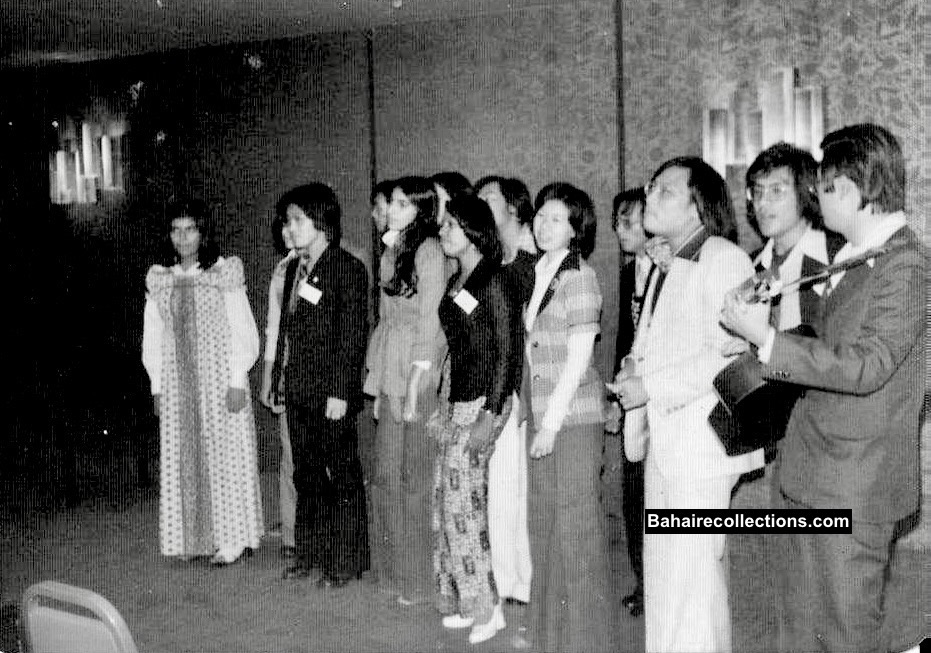
Performance at the International Teaching Conference in Hong Kong, November 1976. Boo Haw at the extreme left. To his right are Tan Lee Soo Hock (white) and Jimmy Seow at the back.
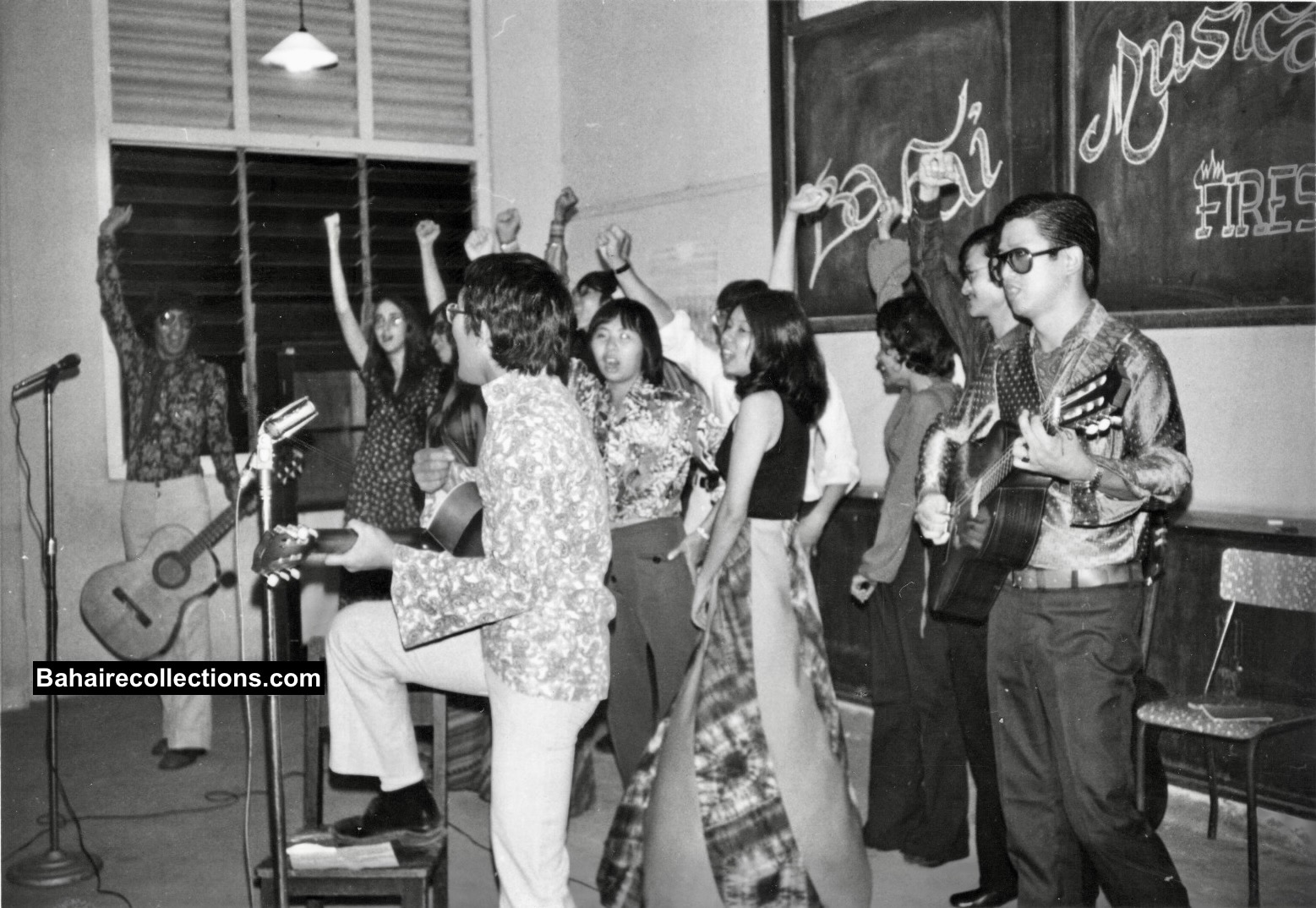
Musical Fireside in Penang, 1974. At extreme left is Jimmy Seow. Boo Haw is with guitar at the extreme right, with Teh Teik Hoe next to him. (Photo Courtesy: Jimmy Seow)
In the 1980s too music continued to permeate the lives of the Alor Star Bahá’ís. 1985 was designated the International Year of Youth by the United Nations. Malaysia then hosted a youth conference in Port Dickson. There was a bus load from Alor Star. The Bahá’í s of Alor Stare prepared a book containing 101 songs in 120 pages, with guitar chords included. Chong Boo Haw, Teh Teik Hoe, Liu Man San, Siew Gaik and Zohrab assisted in the preparation of this book. Siew Gaik typed and checked the wording at a time when computer spell check was not available. They spent many late hours at Boo Haw’s office, which was already another gathering place for the Bahá’ís, ensuring the book was ready for the event. All the 500 copies were sold like hot cakes, at a meagre cost of only 50 cents. That was about the last song book to be produced in Alor Star community. Formed and led a 200 strong voice choir at the Winter School held in Kangar, Perlis in 1998.
Boo Haw had performed ‘Elvis’ many times for the Sultan and the fourth Prime Minister of Malaysia Dr. Mahathir but the highlight of his ‘singing career’ must surely be the rare privilege of singing a duet with Dash Crofts in Penang in 1999.
When the Malaysian Bahá’í Community celebrated its Fiftieth Anniversary of the acceptance of the Faith in Malaya at Ipoh town in 2003, the Alor Star community, especially Chong Boo Haw produced CD “The Apple Falls”. It was “The Apple Falls” album that catapulted Boo Haw into great fame. There were good sales at the event, enabling all music lovers and second generation Bahá’ís to reminisce remember the role of Alor Star in the development of Bahá’í music in this community.
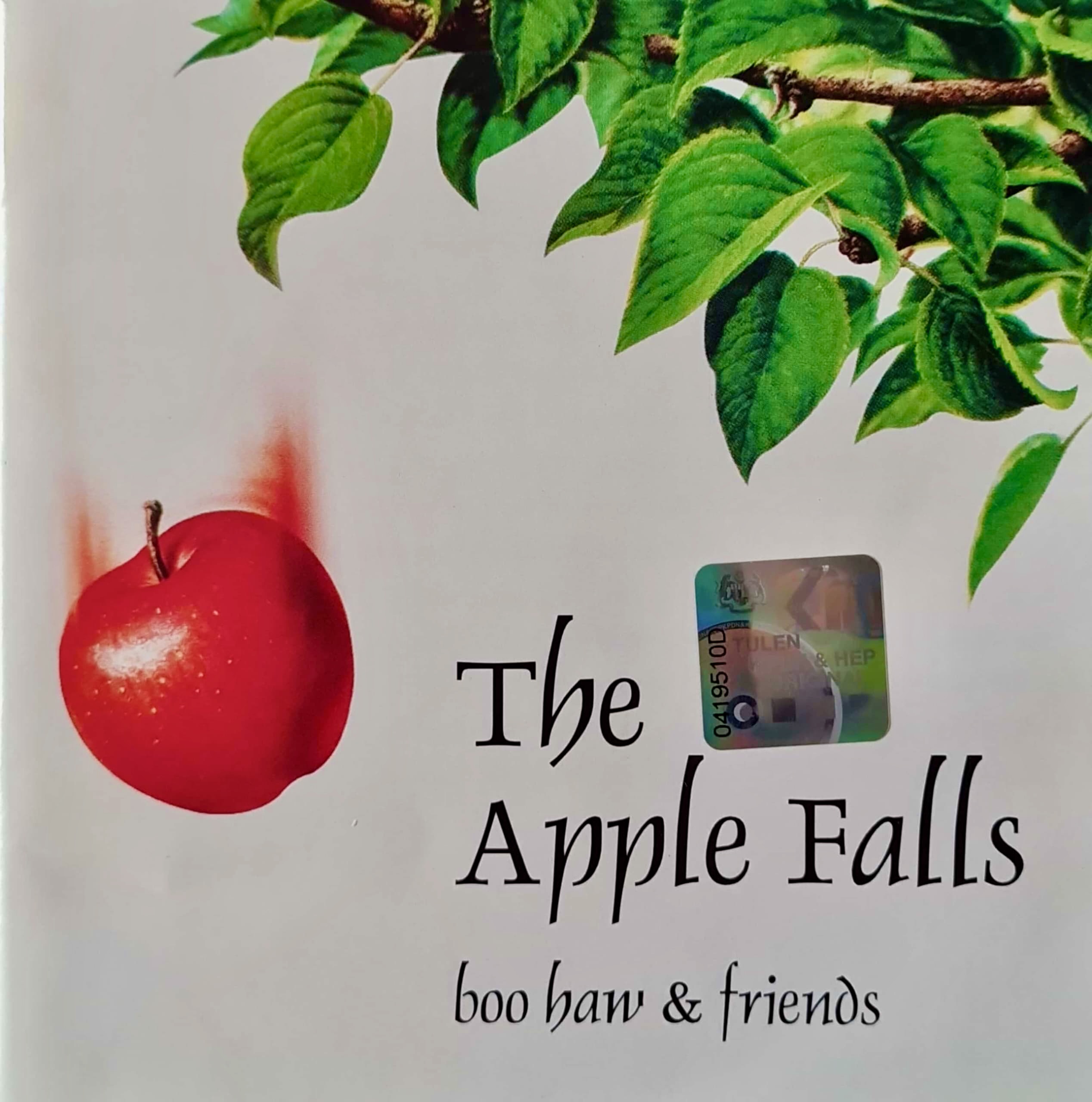
Cover page of The Apple Falls, the Compact Disc.
At the fiftieth anniversary celebrations of the coming of the Faith to Alor Star held at the Sentosa Hotel on 18 August 2010, Boo Haw got a large cross section of the youth to form a large choir which performed moving Bahá’í songs, befitting the occasion. At the Malaysian Winter School held in 2016, Boo Haw, Teik Hoe and Jimmy Seow reunited after singing together 40 years ago and gave a rocking performance enjoyed by more than 1,000 participants.
Boo Haw also wrote the lyrics and composed music based on the Ruhi Book on the Covenant(Ruhi Book 3.p.201) with the music arranged by Edwin Edpalina of the Australian Bahá’í Choir.
Music was synonymous with Boo Haw. Somehow, wherever Boo Haw went, he would invariably be called to strum his guitar. Apart from strumming guitar and singing at all gatherings Boo Haw attended, he also brought music to Asli villages and estate communities. When Boo Haw and Liu Man San went to Singapore in 2014 to conduct a session on the Dawn Breakers, suddenly Boo Haw was called upon to sing some songs, which he gladly did. Only those who had heard him sing the songs soulfully would have got the real and the great feel. With his stellar performances, Boo Haw was a phenomenon like no other.
TOOK MUSIC ABROAD
Boo Haw also took the music abroad. In 1989 he performed in New South Wales, jointly organised by the Bahá’í Communities of Concord, Burwood and Strathfield. This performance received extensive press coverage, and by extension publicity for the Cause. The GLEBE Daily carried the following heading in the Entertainment section, with photo of Boo Haw performing, “ELVIS OF MALAYSIA HAS HIS FANS”.
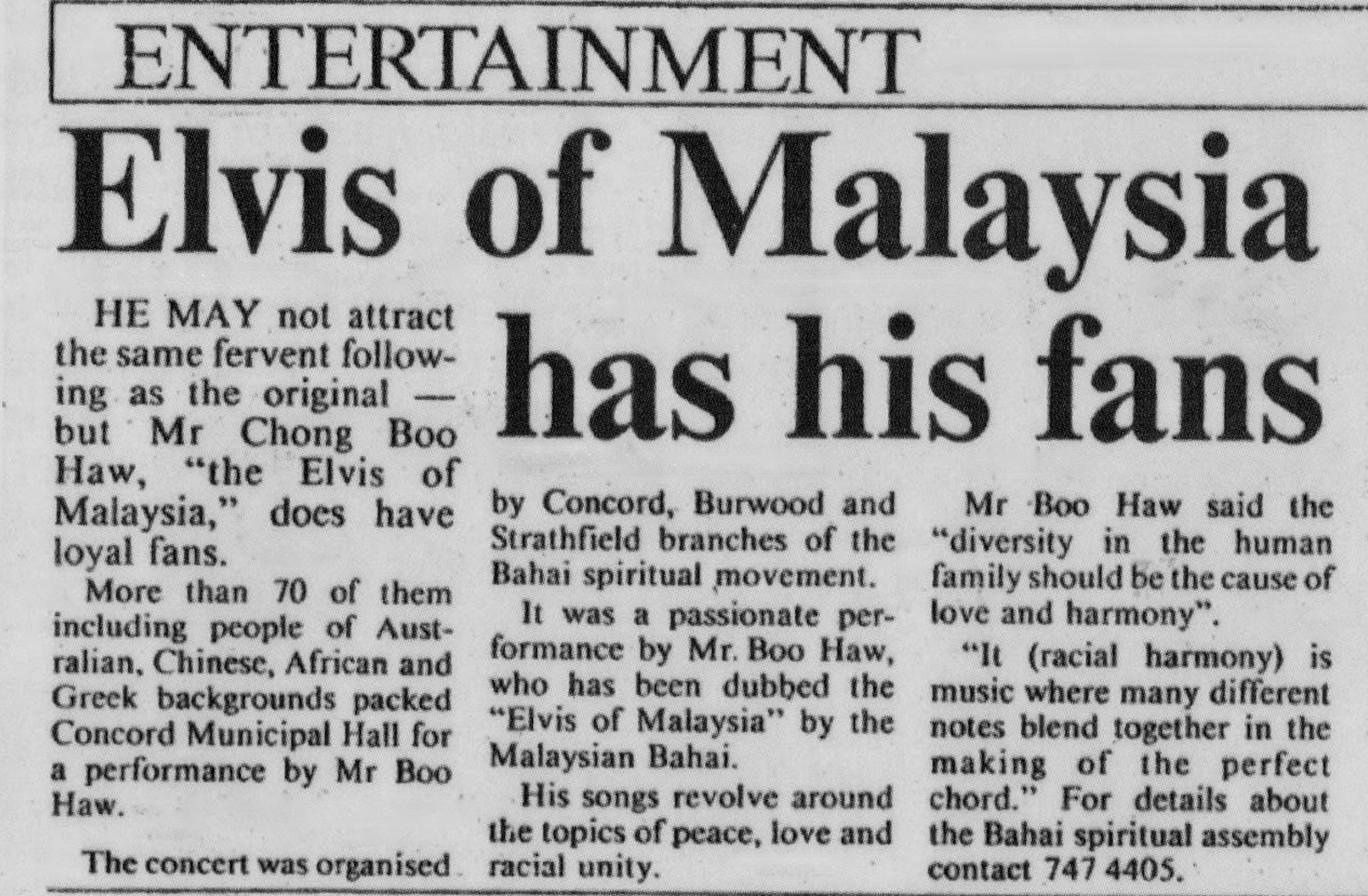
Boo Haw flashed in the news as the Elvis Presley of Malaysia.
Following the performance in the “Voices of Bahá” tour conducted by Tom Price in Penang in 1999, he followed them to perform in Singapore, Hong Kong and Macau.
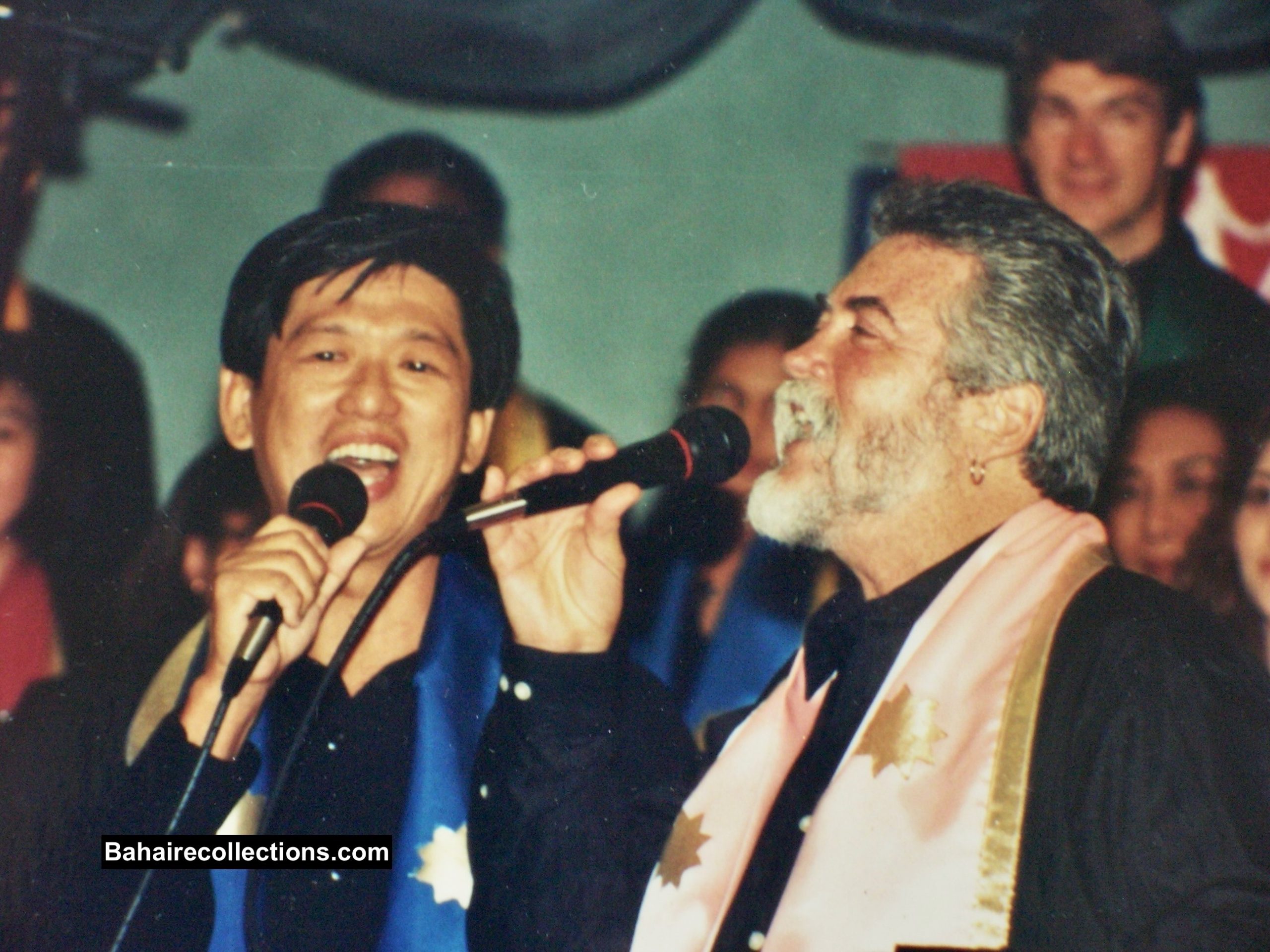
Boo Haw at left and Dash Crofts at right singing a in Penang in 1999.
In 1999 Boo Haw went to Mongolia with his own expenses to conduct training for the Bahá’í choir there. The training was held during the Summer School in Darkhan city. Member of the Supreme Body Dr. Peter Khan and his wife Janet Khan were there at the Summer School.
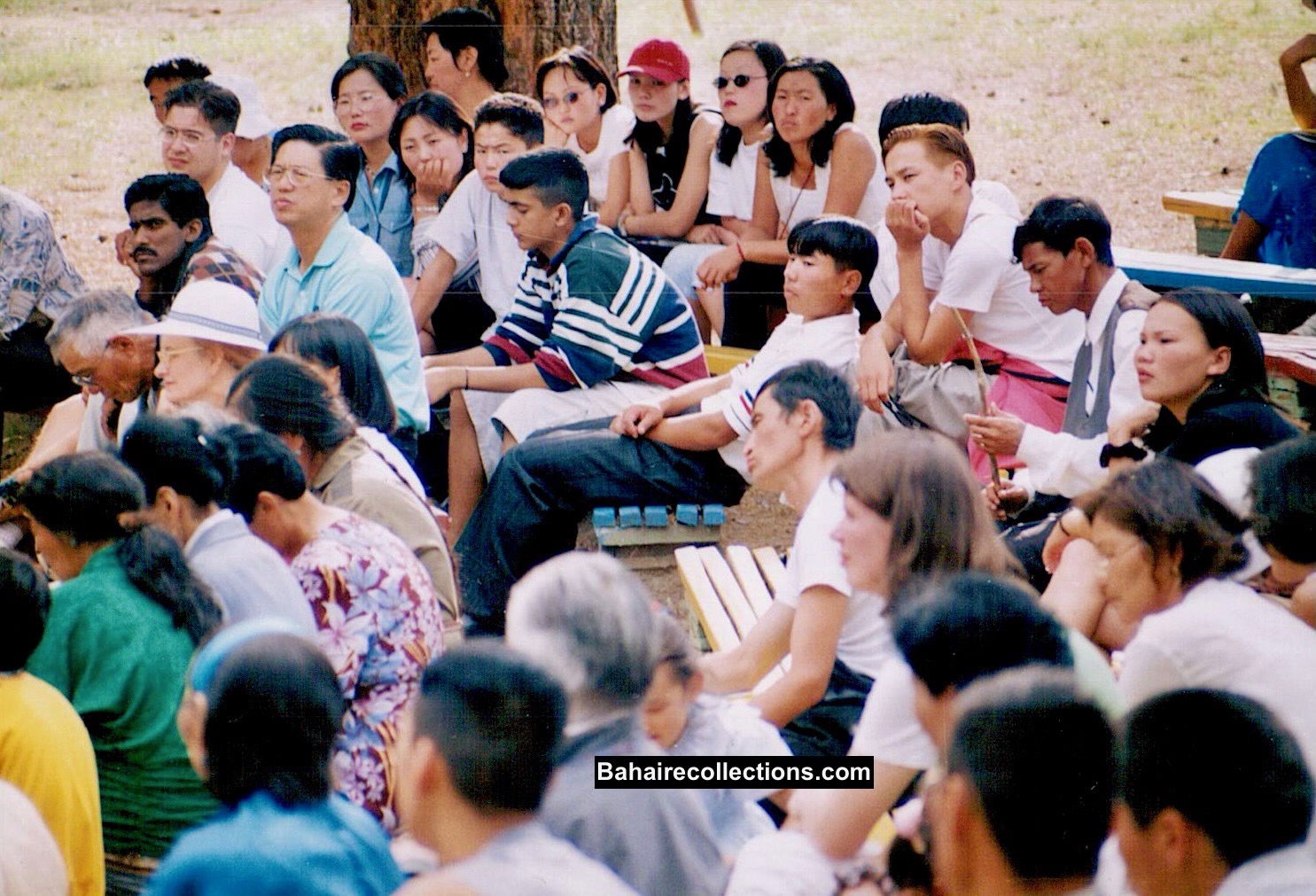
Boo Haw at the top left in light blue T-Shirt at the Summer School in Darkhan city, Mongolia, 1999.
Boo Haw did not confine his musical performances with the community. He was also invited or voluntarily sang with or without guitars at the events held in the Kedah Club, family functions such as birthdays of close friends, weddings of family members or Chinese New Year celebrations.

Boo Haw performing at his family function-by popular demand.
Boo Haw’s usual lively and energetic performance at the Summer School in Ipoh in December 2016.
ARTISTIC TALENTS
Boo Haw was by nature an artistic person, which he used fully for the Faith. The greatness of the man was that he got the community, especially the youth involved in all the artistic pursuits undertaken for the Cause, with the view of developing them as well.
One of the earliest efforts was the banner that was prepared to be placed on a bus that took participants for the Oceanic Conference in Singapore at the end of December 1970 Chong Boo Haw chartered a bus from Alor Star on behalf of the Area Teaching Committee of Kedah and Perlis. The banner read: “BAHÁ’Í OCEANIC CONF.” Boo Haw got the youth to join him in preparing the catchy banner, which proclaimed the Faith all the way from Alor Star to Singapore and back. It did not end there. Boo Haw was the main person who led the youth in decorating the Bahá’í Center or to give a facelift to the interiors. In early 1971 Boo Haw painted the name “Bahá’u’lláh” in Arabic style on top of all window sills in the Alor Star Bahá’í Center. When important events were coming up, especially Naw-Rúz, he would get the youth to join him in painting the walls of the Bahá’í Centre, selecting the right colours.
In encouraging the youth to take up artistic talents, Boo Haw would give talks about painters and their monumental works. In one of the talks, when the author was present, he spoke about Picasso and Michealangelo and paintings like the smiling Mona Lisa. Boo Haw was explaining in minute details on the different interpretations people gave to the paining of Mona Lisa. Boo Haw said to his effect, “Some said she was not smiling, she was just natural; some said she had eyes that had just shed tears; some said her eyes would follow you wherever you move; looking at her fingers some said she was actually pregnant; looking at the background, some said the artist was very disturbed when he was painting…” His talk was like penetrating through clouds.
The audience remained spellbound for a moment. And suddenly one excited youth shouted, “Boo Haw, Alor Star is not the place for you. Go to Kuala Lumpur which may have the proper platform for you to demonstrate your full talents”. All laughed!
THE NORTHERN STAR
Boo Haw was certainly destined to do great things for the Cause through his penmanship and drawing skills. Boo Haw had already developed his editorial skills during his Form Three days in his school. He also contributed a cartoon for his school’s annual magazine. In the Malayan Teachers’ College, he was elected editor by the Students’ Council. While working in the Finance Company, he was the editor of the “Berita SAHOCA” which is Newsletter of the Sultan Abdul Hamid College Old Boys Association.
Boo Haw wedded his drawing skills with his able penmanship in taking the lead in the production of the much celebrated and well-remembered “The Northern Star” newsletter. In July 1970, the Area Teaching Committee of Kedah/Perlis released its first issue of the newsletter called “Kedah-Perlis Bahá’í News”. At that time, it was called Kedah/Perlis BAHA’I NEWS. It was the mighty effort and hard work of Chong Boo Haw that saw the birth of this official chronicle of activities of the Area Teaching Committee of Kedah/Perlis. Members of the Editorial Board were Teh Teik Hoe, Tan Boon Tin, R. Ganasa Murthi.
In January 1971 it became known as “The Northern Star”. The original editor was R. Ganasa Murthi, but later Boo Haw took over as its Chief Editor. Boo Haw used his artistic skills to draw beautiful pictures, together with attractive captions in his beautiful handwriting. It attracted many readers from across the country for its very spicy and interesting stories, news items, and of course the “God Loves Laughter” section. The letters to the editor mainly from Malaysian pioneers abroad were very well received. After office hours at the Central Malaysian Finance, the members of the Editorial Board would gather at the back of the office and did the typing of the newsletter on stencils. They would then adjourn to the Bahá’í Centre at 7 Jalan Serai where other youth would do the cyclostyling and stapling. Boo Haw was certainly destined to become the editor of this newsletter.
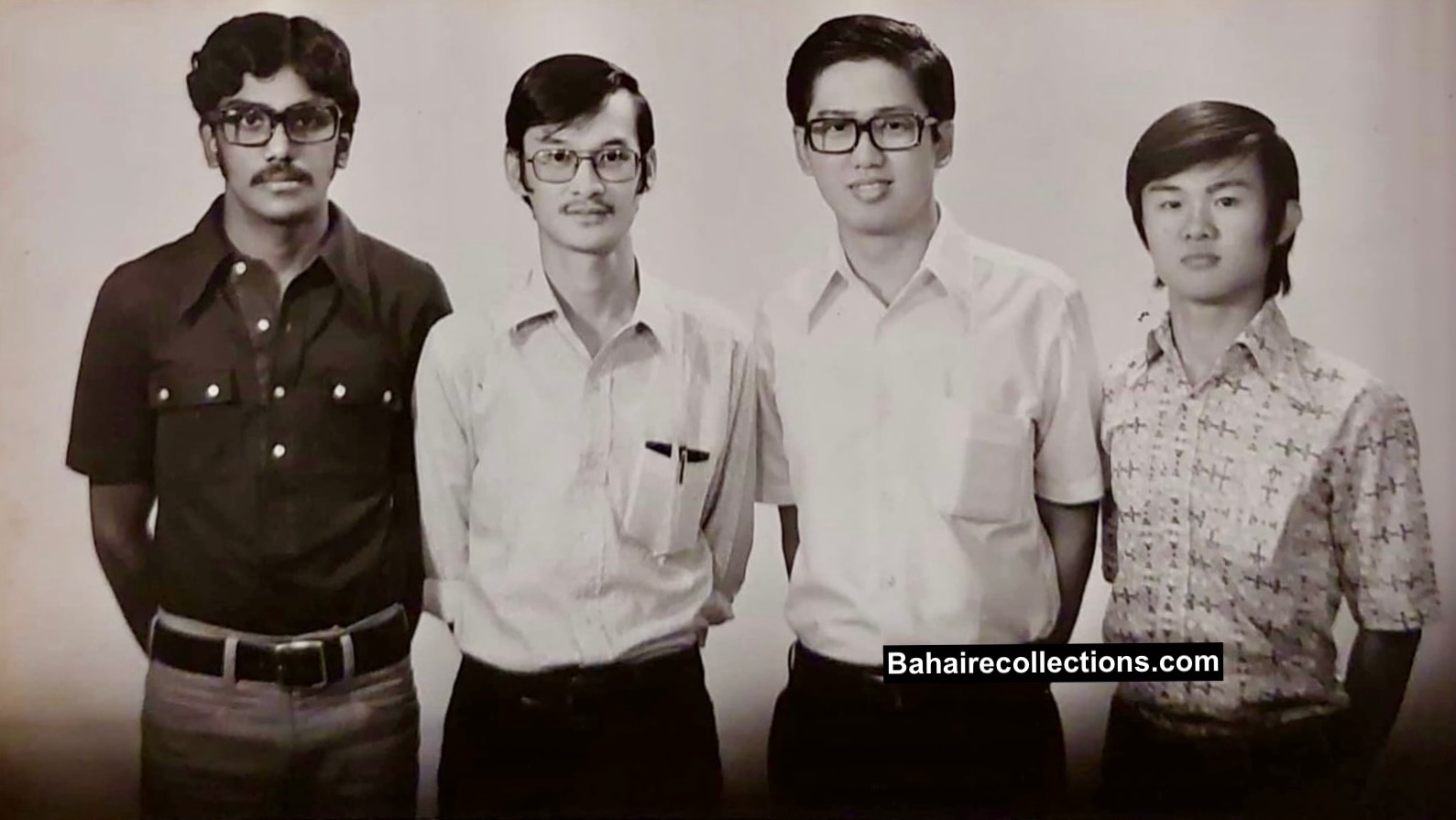
No comments:
Post a Comment